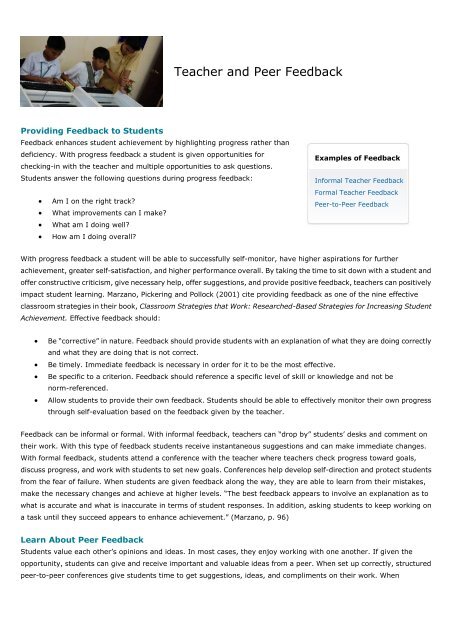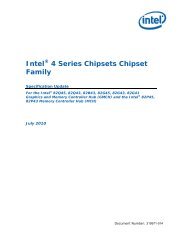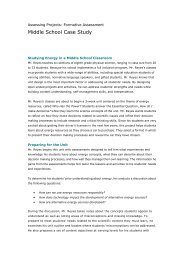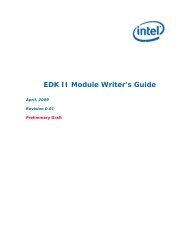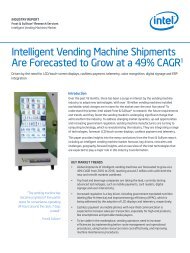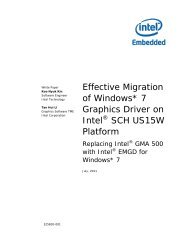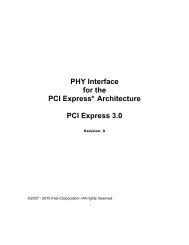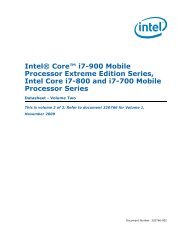Teacher and Peer Feedback - Intel
Teacher and Peer Feedback - Intel
Teacher and Peer Feedback - Intel
You also want an ePaper? Increase the reach of your titles
YUMPU automatically turns print PDFs into web optimized ePapers that Google loves.
<strong>Teacher</strong> <strong>and</strong> <strong>Peer</strong> <strong>Feedback</strong>Providing <strong>Feedback</strong> to Students<strong>Feedback</strong> enhances student achievement by highlighting progress rather th<strong>and</strong>eficiency. With progress feedback a student is given opportunities forchecking-in with the teacher <strong>and</strong> multiple opportunities to ask questions.Students answer the following questions during progress feedback: Am I on the right track? What improvements can I make? What am I doing well? How am I doing overall?Examples of <strong>Feedback</strong>Informal <strong>Teacher</strong> <strong>Feedback</strong>Formal <strong>Teacher</strong> <strong>Feedback</strong><strong>Peer</strong>-to-<strong>Peer</strong> <strong>Feedback</strong>With progress feedback a student will be able to successfully self-monitor, have higher aspirations for furtherachievement, greater self-satisfaction, <strong>and</strong> higher performance overall. By taking the time to sit down with a student <strong>and</strong>offer constructive criticism, give necessary help, offer suggestions, <strong>and</strong> provide positive feedback, teachers can positivelyimpact student learning. Marzano, Pickering <strong>and</strong> Pollock (2001) cite providing feedback as one of the nine effectiveclassroom strategies in their book, Classroom Strategies that Work: Researched-Based Strategies for Increasing StudentAchievement. Effective feedback should:Be “corrective” in nature. <strong>Feedback</strong> should provide students with an explanation of what they are doing correctly<strong>and</strong> what they are doing that is not correct.Be timely. Immediate feedback is necessary in order for it to be the most effective.Be specific to a criterion. <strong>Feedback</strong> should reference a specific level of skill or knowledge <strong>and</strong> not benorm-referenced.Allow students to provide their own feedback. Students should be able to effectively monitor their own progressthrough self-evaluation based on the feedback given by the teacher.<strong>Feedback</strong> can be informal or formal. With informal feedback, teachers can “drop by” students’ desks <strong>and</strong> comment ontheir work. With this type of feedback students receive instantaneous suggestions <strong>and</strong> can make immediate changes.With formal feedback, students attend a conference with the teacher where teachers check progress toward goals,discuss progress, <strong>and</strong> work with students to set new goals. Conferences help develop self-direction <strong>and</strong> protect studentsfrom the fear of failure. When students are given feedback along the way, they are able to learn from their mistakes,make the necessary changes <strong>and</strong> achieve at higher levels. “The best feedback appears to involve an explanation as towhat is accurate <strong>and</strong> what is inaccurate in terms of student responses. In addition, asking students to keep working ona task until they succeed appears to enhance achievement.” (Marzano, p. 96)Learn About <strong>Peer</strong> <strong>Feedback</strong>Students value each other’s opinions <strong>and</strong> ideas. In most cases, they enjoy working with one another. If given theopportunity, students can give <strong>and</strong> receive important <strong>and</strong> valuable ideas from a peer. When set up correctly, structuredpeer-to-peer conferences give students time to get suggestions, ideas, <strong>and</strong> compliments on their work. When
conferences are productive, students are aware of what to look for <strong>and</strong> have specific criteria to follow as they work withtheir peers. Evaluation guides or checklists can be h<strong>and</strong>y tools to keep students on task <strong>and</strong> remind them to offer positivefeedback as well as suggestions <strong>and</strong> ideas. With practice <strong>and</strong> modeling, teachers can implement this strategy into theclassroom at any time for a variety of purposes.Make it Happen in Your Classroom<strong>Teacher</strong> <strong>and</strong> peer feedback can take place at any grade level <strong>and</strong> with any subject area. Embedding informal <strong>and</strong> formalfeedback into the classroom is an effective <strong>and</strong> worthwhile strategy. Learn about ways to implement this strategy into theclassroom.Informal <strong>Teacher</strong> <strong>Feedback</strong> >Check-ups <strong>and</strong> check-ins are used to see how students are progressing, answer questions, or help with ideas.Formal <strong>Teacher</strong> <strong>Feedback</strong> >With the use of conferences, teachers can provide suggestions <strong>and</strong> comments along with individualized goal setting.<strong>Peer</strong>-to-<strong>Peer</strong> <strong>Feedback</strong> >With the use of structured peer conferences students give <strong>and</strong> receive feedback on their current work.
Designing Effective Projects: <strong>Teacher</strong> <strong>and</strong> <strong>Peer</strong> <strong>Feedback</strong>Informal <strong>Teacher</strong> <strong>Feedback</strong>Making the Most of Informal EncountersInformal teacher feedback can take the place of many different forms. This type of feedback is designed to give studentson-the-spot responses to work they are immersed in at the time. The teacher can use this time to answer questions,provide suggestions, or just check in with the student to see how they are progressing. Informal feedback can be done inthe form of:Periodic check ups Students are assigned a few minutes each day to check in withthe teacher <strong>and</strong> go over any questions or ideas they may wantto discuss before continuing with the workA stop by a student’s desk A short visit with a few students during a work period to checkin on how they are doing, answer questions, <strong>and</strong> offer feedbackWritten responses in a learning log or on thework itselfRespond to students’ entries in learning logs or journals, posequestions, <strong>and</strong> offer ideasWrite comments on tests, reports, papers, <strong>and</strong> other workproducts that prompt students to see mistakes <strong>and</strong> askquestionsAllow students time to retake a test or find the right answerswith some improvement to their original score
Designing Effective Projects: <strong>Teacher</strong> <strong>and</strong> <strong>Peer</strong> <strong>Feedback</strong>Formal <strong>Teacher</strong> <strong>Feedback</strong>Student-<strong>Teacher</strong> Conferences<strong>Teacher</strong>s can provide feedback through structured conferences with specific goals. Conferences focus on suggestions <strong>and</strong>comments along with individualized goal setting on a formal level. <strong>Teacher</strong>s can meet with a few students a day or a weekdepending on specific projects, deadlines, <strong>and</strong> individual student needs. It is important to set up these conferences in astructured way so both teacher <strong>and</strong> student make good use of their time. Below is a list of helpful hints for setting upstudent-teacher conferences.The teacher should look at student work beforeh<strong>and</strong>A checklist or feedback form should accompany the workComments should be specific to the work <strong>and</strong> elaborated on during the conferenceThe teacher should focus on two to three items that need work <strong>and</strong> be prepared to share examples on how toimprove themPlenty of positive feedback should be shared throughout the conferenceTime for the student to ask questions <strong>and</strong> give input should be allottedStudent should be able to take the feedback form/checklist with them at the end of the conference to use as areference in making revisionsThe main goal should be to meet with the students two or more times during the course of a project. This way, studentsare given multiple opportunities to make sure they are on the right track <strong>and</strong> make necessary improvements to their work.Using formal conferencing along with informal feedback, students are protected from failure <strong>and</strong> set up for success.<strong>Teacher</strong><strong>Feedback</strong> FormStudent name: _____________________________Title of work: _____________________________Conference time: _____________________________1. Some things you did successfully:__________________________________________________________________________________________________________________________________________________________________________________
_________________________________________________________________________________________2. Some things you could improve upon:___________________________________________________________________________________________________________________________________________________________________________________________________________________________________________________________________________3. Next steps:___________________________________________________________________________________________________________________________________________________________________________________________________________________________________________________________________________Note: Keep this feedback form to refer to as you revise your work.
Designing Effective Projects: <strong>Teacher</strong> <strong>and</strong> <strong>Peer</strong> <strong>Feedback</strong><strong>Peer</strong>-to-<strong>Peer</strong> <strong>Feedback</strong><strong>Peer</strong> ConferencesWith the use of structured peer conferences, students give <strong>and</strong> receive feedback about ongoing work. The most importantcomponent of peer feedback is the modeling that occurs beforeh<strong>and</strong>. It is imperative that teachers model <strong>and</strong> role playhow to give feedback in a constructive way before having students meet on their own. Set out on their own to givefeedback, many students will use the time to chat, criticize the other students’ work or get nothing done. Students needto be held accountable for the comments, suggestions, <strong>and</strong> feedback they are giving one another <strong>and</strong> need to know aheadof time how to do this effectively. Providing students with a peer feedback form, which will be checked by the teacher, canprovide structure to peer conferences. Once students have had time to practice, know what the requirements are, <strong>and</strong> areaware of expectations, peer conferences can be an integral part of the feedback process.<strong>Peer</strong> feedback can be done at any time during the course of a project. It can be used as a starting point to get ideas, orcan be structured to give students feedback in the middle of the project so they can revise their work based on their peers’input. It can also be helpful to get peer feedback before a teacher conference, so the work is more refined <strong>and</strong> has beenlooked at by others. <strong>Peer</strong> feedback can be given at multiple stages during a larger project or during the course of a writtenproject that uses the writing process steps. A peer feedback form is needed so students are focused on giving the rightkinds of feedback <strong>and</strong> know what the expectations of the conference are.<strong>Peer</strong> <strong>Feedback</strong> FormYour name: ________________________________<strong>Peer</strong> reviewer’s name: ________________________________Title of project: ________________________________1. Two compliments about the work are:____________________________________________________________________________________________________________________________________________________________________________________________________________________________________________________________________________________
____________________________________________________________________________________________2. Two suggestions about the work are:________________________________________________________________________________________________________________________________________________________________________________________________________________________________________________________________________________________________________________________________________________________________________________Note: Have the peer reviewer use “I” statements for this step:I would like to know more about…I am not sure what this means....I would like to know more details about....3. Any other ideas or comments:________________________________________________________________________________________________________________________________________________________________________________________________________________________________________________________________________________________________________________________________________________________________________________Note: Keep this form to refer to as you revise your work.


